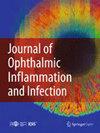Corneal ring infiltrate- far more than Acanthamoeba keratitis: review of pathophysiology, morphology, differential diagnosis and management
IF 2.9
Q1 OPHTHALMOLOGY
Journal of Ophthalmic Inflammation and Infection
Pub Date : 2023-12-19
DOI:10.1186/s12348-023-00379-6
引用次数: 0
Abstract
Ring infiltrates usually accompany numerous infectious and sterile ocular disorders. Nevertheless, systemic conditions, drugs toxicity and contact lens wear may present with corneal ring infiltrate in substantial part. Considering its detrimental effect on vision, detailed knowledge on etiology, pathophysiology, differential diagnosis, and management should be considered essential for every ophthalmologist. The PUBMED database was searched for “corneal ring infiltrate” and “ring infiltrate” phrases, “sterile corneal infiltrate” and “corneal infiltrate”. We analyzed articles written in English on risk factors, pathophysiology, clinical manifestation, morphological features, ancillary tests (anterior-segment optical coherence tomography, corneal scraping, in vivo confocal microscopy), differential diagnosis and management of corneal ring infiltrate. Available literature depicts multifactorial origin of corneal ring infiltrate. Dual immunological pathophysiology, involving both antibodies-dependent and -independent complement activation, is underlined. Furthermore, we found that the worldwide most prevalent among non-infectious and infectious ring infiltrates are ring infiltrates related to contact-lens wear and bacterial keratitis respectively. Despite low incidence of Acanthamoeba keratitis, it manifests with corneal ring infiltrate with the highest proportion of the affected patients (one third). However, similar ring infiltrate might appear as a first sign of general diseases manifestation and require targeted treatment. Every corneal ring infiltrate with compromised epithelium should be scraped and treat as an infectious infiltrate until not proven otherwise. Of note, microbiological ulcer might also lead to immunological ring and therefore require anti-inflammatory treatment. Corneal ring infiltrate might be triggered not only by ocular infectious and non-infectious factors, but also by systemic conditions. Clinical assessment is crucial for empirical diagnosis. Furthermore, treatment is targeted towards the underlying condition but should begin with anti-infectious regimen until not proven otherwise.角膜环浸润--远不止阿卡阿米巴角膜炎:病理生理学、形态学、鉴别诊断和处理方法综述
角膜环浸润通常伴随着许多感染性和无菌性眼部疾病。然而,全身性疾病、药物中毒和佩戴隐形眼镜也可能导致角膜环浸润。考虑到角膜环浸润对视力的不利影响,详细了解病因、病理生理学、鉴别诊断和处理方法应被视为每位眼科医生的必修课。我们在 PUBMED 数据库中搜索了 "角膜环浸润"、"角膜环浸润"、"无菌性角膜浸润 "和 "角膜浸润"。我们分析了有关角膜环浸润的风险因素、病理生理学、临床表现、形态特征、辅助检查(前段光学相干断层扫描、角膜刮片、活体共聚焦显微镜)、鉴别诊断和处理的英文文章。现有文献描述了角膜环浸润的多因素起源。强调了双重免疫病理生理学,包括抗体依赖性和非依赖性补体激活。此外,我们还发现,在全球范围内,非感染性和感染性角膜环浸润中最常见的分别是与佩戴隐形眼镜和细菌性角膜炎有关的角膜环浸润。尽管棘阿米巴角膜炎的发病率较低,但其表现为角膜环状浸润的患者比例最高(三分之一)。然而,类似的角膜环状浸润可能是一般疾病的首发症状,需要进行针对性治疗。对每一个上皮受损的角膜环状浸润都应进行刮除,并将其视为感染性浸润,直到不能证实其为感染性浸润为止。值得注意的是,微生物性溃疡也可能导致免疫性角膜环,因此需要抗炎治疗。角膜环浸润不仅可能由眼部感染性和非感染性因素引发,也可能由全身性疾病引发。临床评估对于经验性诊断至关重要。此外,治疗应针对潜在的疾病,但在没有其他证据之前,应从抗感染治疗开始。
本文章由计算机程序翻译,如有差异,请以英文原文为准。
求助全文
约1分钟内获得全文
求助全文
来源期刊

Journal of Ophthalmic Inflammation and Infection
OPHTHALMOLOGY-
CiteScore
3.80
自引率
3.40%
发文量
39
审稿时长
13 weeks
 求助内容:
求助内容: 应助结果提醒方式:
应助结果提醒方式:


